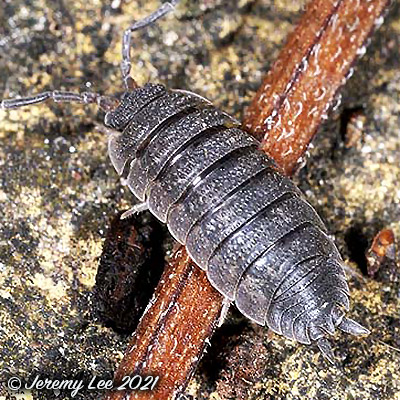
 |
|
Scientific Classifications explained » Amphibians » Ants » Aphids » Bees » Beetles » Birds » Bugs » Butterflies » Caterpillars » Damselflies » Dragonflies » Earwigs » Flies » Frog/Leafhoppers » Fungi » Galls » Grasshoppers » Harvestmen » Hoverflies » Lacewings » Ladybirds » Leaf Mines » Lichens » Mammals » Millipedes » Mosses » Moths » Sawflies » Slugs » Snails » Spiders » Trees » Wasps » Wild Flowers » Woodlice |
UK Nature > Woodlice > Porcellio scaber

Scientific Name: Porcellio scaber Common Name: Common Rough Woodlouse Up to 17mm in length, Porcellio scaber, or the Common Rough Woodlouse, is probably the commonest species of woodlouse found in the UK, very often showing up in houses. Found throughout the UK, it loves damp, shaded places - lift any large stone, log, or even a pot from your patio and you'll find them, usually feeding on dead plant matter. It is usually grey in colour, but can be mottled with yellow or brown. When viewed under a hand lens you'll see where the "rough" name comes from. The upper surface is covered in bumps. If you turn the creature over you'll notice it has two pairs of lungs, which appear as white patches near the tail end. The end of the antennae (the Flagellum) is in two segments. The eyes are composed of a group of shiny black bumps (called 'ocelli'). |
|

https://www.uknature.co.uk is a website dedicated to showing the immense diversity of UK nature and wildlife. Our vast range of habitats, from lowland arable to snow covered mountains, from storm-ravaged coastlines to peaceful inland freshwater lakes and rivers, from dry, sandy heaths to deciduous and coniferous forests, all these habitats contribute to the abundance of UK nature. We have wild birds in huge numbers either residing or visiting our shores (597 recorded species as at July 2013) and we must also not forget the humble back garden with its grass lawns, flower beds filled with nectar rich flowers, shrubs and trees, all designed to attract huge numbers of insects such as bees, moths, butterflies and hoverflies; and finally the small ponds which provide safe havens for frogs, toads, newts and even slow worms and grass snakes. www.uknature.co.uk is the showcase for my personal passion, photographing uknature in all its glory. I sincerely hope you all enjoy the fruits of my labours. This site and all images contained therein is © Jeremy Lee 2004 - 2021. All Rights Reserved. Site design by Jeremy Lee. Site development & IT Support by Stuart Lee. |